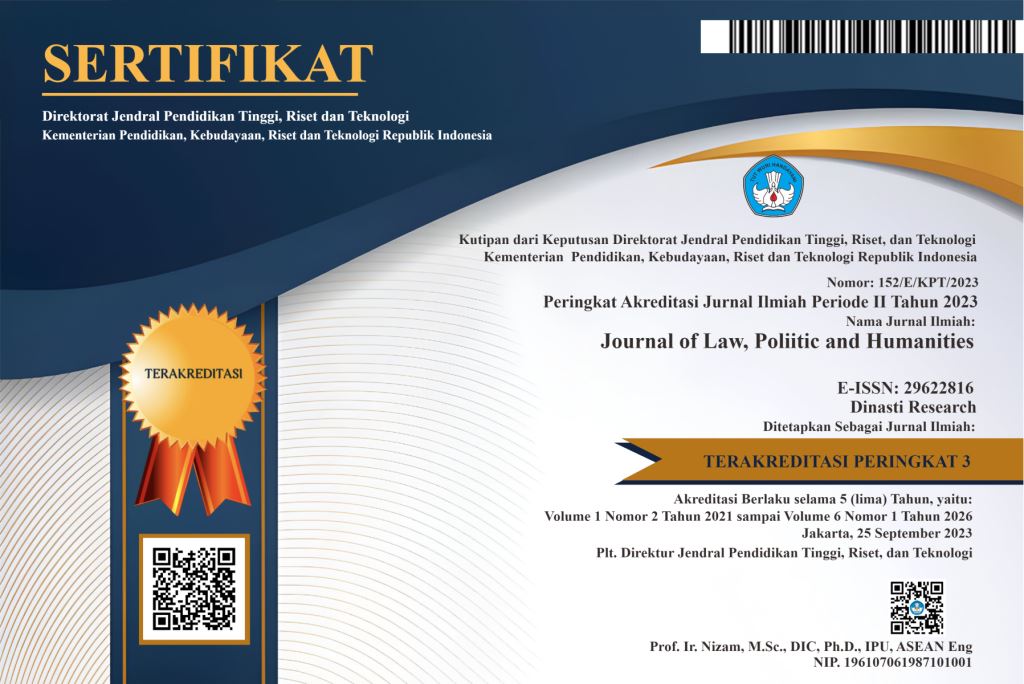Analysis Of The Crime Of Premeditated Murder Using Cyanide Poison in the Perspective of Routine Activity Theory (Case Study in Sukabumi City)
DOI:
https://doi.org/10.38035/jlph.v4i4.368Keywords:
Cyanide, Murder, Premeditated Murder, Routine Activity Theory, SukabumiAbstract
This research investigates the phenomenon of premeditated murder using cyanide poison in the context of the Routine Activity Theory perspective. The focus of this research is a case study of premeditated murder using poison committed in Sukabumi City. The research method used involved qualitative analysis of data from various sources, including police reports, forensic results, and interviews with relevant parties. The purpose of this study was to determine the compatibility between routine activity theory and premeditated murder, which in this study used cyanide poison. The results showed that the crime of premeditated murder using cyanide poison often involves a planning process that is integrated with the routine activities of the perpetrator and victim. Routine Activity Theory provides an in-depth understanding of how such crimes are planned, executed and ultimately executed. In the context of the case studied, the perpetrator provided magical money-multiplying services through rituals, capitalizing on the victim's belief in the supernatural without conducting prior research, which ultimately led to the victim's death from poisoning. The findings highlight the importance of understanding the factors that influence offenders' success in planning and executing crimes, and the implications for prevention and law enforcement efforts. This research also contributes to the theoretical understanding of the relationship between routine activities and premeditated crimes, as well as providing practical insights for law enforcement officials in dealing with similar cases in the future.
References
Benuf, K., & Azhar, M. (2020). Metodologi Penelitian Hukum sebagai Instrumen Mengurai Permasalahan Hukum Kontemporer. Jurnal Gema Keadilan, 7(1), 20-33.
BPS. (2021, November 8). Jumlah Kasus Kejahatan Pembunuhan Pada Satu Tahun Terakhir (Kasus), 2020. Retrieved April 13, 2024 from bps.go.id: https://www.bps.go.id/id/statistics-table/2/MTMwNiMy/jumlah-kasus-kejahatan-pembunuhan-pada-satu-tahun-terakhir--kasus-.html
Cahyawati, P. N., Zahran, I., & Jufri, M. I. (2017). Keracunan Akut Sianida. Wicaksana, Jurnal Lingkungan & Pembangunan, 1(1), 80-87.
Cohen, L. E., & Felson, M. (1979). Social Change and Crime Rate Trends: A Routine Activity Approach. American Sociological Review, 44(4), 588-608.
Dihni, V. A. (2022, Februari 14). Jumlah Kasus Pembunuhan di Indonesia (2016-2020). Retrieved April 13, 2024 from databoks.katadata.co.id: https://databoks.katadata.co.id/datapublish/2022/02/14/kasus-pembunuhan-di-indonesia-terus-berkurang-dalam-5-tahun-terakhir
Hafid, A. (2015). Kajian Hukum Tentang Pembunuhan Berencana Menurut Pasal 340 Kuhp. Lex Crimen, 4(4), 86-91.
Ilyas, A. (2012). Asas-Asas Hukum Pidana. Yogyakarta: Rangkang Education & PuKAP.
kumparanNEWS. (2021, Mei 5). Data Kasus Pembunuhan dengan Racun di RI: Sianida Paling Sering Digunakan. Retrieved April 13, 2024 from kumparan.com: https://kumparan.com/kumparannews/data-kasus-pembunuhan-dengan-racun-di-ri-sianida-paling-sering-digunakan-1vgPscIMLzM
Marpaung, L. (2012). Asas - Teori - Praktik Hukum Pidana. Jakarta: Sinar Grafika.
Novitasari. (2019). Penerapan Dissenting Opinion Terhadap Pembebasan Terdakwa Dalam Tindak Pidana Pembunuhan Berencana. Jurnal Verstek, 7(2), 159-166.
Nurhadiyanto, L. (2020). Analisis Cyber Bullying Dalam Perspektif Teori Aktivitas Rutin Pada Pelajar SMA Di Wilayah Jakarta Selatan. Jurnal IKRA-ITH Humaniora, 4(2), 113-124.
Nuzan, N. D., Simatupang, G. E., Situmorang, F. N., Meiliani, & Burnama, Y. (2023). Analisis Kasus Hukum Kopi Sianida Mirna Salihin: Implikasi Hukum Pidana dan Prosedur Hukum Indonesia. Jurnal Kewarganegaraan, 7(2), 2051-2055.
Polresta Sukabumi. (2022, September 26). 2 Pria Dibunuh Pakai Sianida, Modus Sadis Sindikat Penggandaan Uang di Sukabumi. Retrieved April 13, 2024 from humas.polri.go.id: https://humas.polri.go.id/2022/09/26/2-pria-dibunuh-pakai-sianida-modus-sadis-sindikat-penggandaan-uang-di-sukabumi/
Purwono. (2008). Studi Kepustakaan. Yogyakarta: Pustakawan Utama UGM.
Putra, I. K., & Santoso, B. (2017). Tinjauan Judex Factie Salah Menilai Alat Bukti Surat Baru Dalam Perkara Pembunuhan Menurut Pasal 339 KUHP (Studi Putusan Mahkamah Agung Nomor :1086 K/Pid/2013). Jurnal Verstek, 5(2), 53-64.
Rahman, A. S., Junaidi, A., & Mahmud, H. (2022). Pelaksanaan Penyidikan Terhadap Tindak Pidana Mendistribusikan Dokumen Bermuatan Kesusilaan yang Disertai Ancaman Kekerasan di Wilayah Hukum Polres Sukoharjo. Jurnal Serambi Hukum, 15(2), 27-36.
Rohman, A. (2016). Upaya Menekan Angka Kriminalitas Dalam Meretas Kejahatan Yang Terjadi Pada Masyarakat. Perspektif, 125-134.
Sitepu, K. A., Lubis, Y., & Sahlepi, M. A. (2023). Peran Penyidik Dalam Mengungkap Pelaku Tindak Pidana Pembunuhan Berencana Disertai Dengan Mutilasi (Studi di Kepolisian Daerah Sumatera Utara). Jurnal Meta Hukum, 2(3), 63-76.
Sugiyono. (2019). Metode Penelitian Kuantitatif, Kualitatif dan R&D. Bandung: Alfabeta.
Sumarlin, A., Sulistyawati, S., & Setyawan, I. (2019). Analisis Mengenai Faktor-Faktor Orang Dapat Melakukan Tindak Pidana Pembunuhan. Prosiding Seminar Nasional & Expo II Hasil Penelitian dan Pengabdian Masyarakat 2019. 2, pp. 1376-1385. Medan: Universitas Muslim Nusantara Al Washliyah.
Syamsani, F. N., & Yudiantara, I. G. (2023). Analisis Terhadap Tindak Pidana Pembunuhan Yang Dilakukan Oleh Anak Dibawah Umur. Jurnal Kertha Desa, 11(6), 2637-2650.
Yusuf, A. N., & Syarifuddin, A. (2017). Penegakan Hkum Pidana Dalam Penanggulangan Pembunuhan Anak Dibawah Umur Di Wilayah Tungkal Ulu. Legalitas, 9(1), 1-16.
Downloads
Published
How to Cite
Issue
Section
License
Copyright (c) 2024 Triny Srihadiati, Abdur Rozak

This work is licensed under a Creative Commons Attribution 4.0 International License.
Authors who publish their manuscripts in this journal agree to the following conditions:
- The copyright on each article belongs to the author(s).
- The author acknowledges that the Journal of Law, Poliitic and Humanities (JLPH) has the right to be the first to publish with a Creative Commons Attribution 4.0 International license (Attribution 4.0 International (CC BY 4.0).
- Authors can submit articles separately, arrange for the non-exclusive distribution of manuscripts that have been published in this journal into other versions (e.g., sent to the author's institutional repository, publication into books, etc.), by acknowledging that the manuscript has been published for the first time in the Journal of Law, Poliitic and Humanities (JLPH).


























